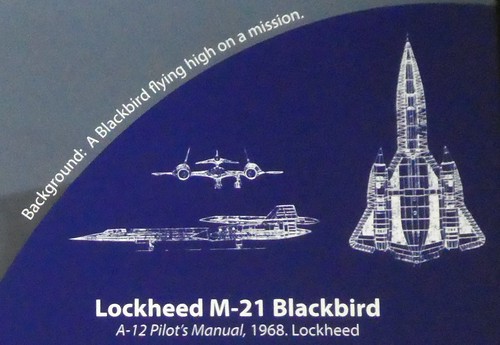The Museum of Flight in Seattle, Washington, is the largest independent, non-profit air and space museum in the world. It has more than 175 aircraft and spacecraft. The T. A. Wilson Great Gallery is a 3 million-cubic-foot, six-story, glass-and-steel exhibit hall currently containing 39 full-size historic aircraft, including the 1963 Lockheed Blackbird M-21.

According to the Museum:
“The Blackbird family of aircraft cruised at speeds of more than Mach 3 and flew over 85,000 feet (25,500 m) in altitude. Conceived in the 1950s, Blackbirds remain the fastest and highest flying air-breathing production aircraft ever built.
In 1959, Lockheed’s chief engineer Kelly Johnson and his team submitted an unsolicited proposal to the U.S. Air Force for a Mach 3+ reconnaissance aircraft. The resulting vehicle, called the A-12 (the twelfth of a series of Lockheed designs), was ordered first by the Central Intelligence Agency. Most of these aircraft were single-seat configuration, but two were built as two-seaters for potential later use as drone-launchers. The A-12 pioneered the use of major titanium structures, composite materials, and low radar cross-section technology. It required advances in design methods, fabrication techniques, and fuels. The prototype first flew in April 1962.
The Blackbird, as it was unofficially called, looked and performed far ahead of its time. The CIA operated the A-12 on clandestine missions through 1968. The A-12 spawned the USAF YF-12A interceptor program, which was eventually canceled. The most famous Blackbird variant, the SR-71, was developed for the USAF and flew frontline reconnaissance missions until 1990. Three SR-71s continued their careers into the late 1990s as NASA research testbeds. Although several Blackbirds were lost in accidents, none were ever shot down.
Key to the performance of the Blackbird was the Pratt & Whitney J58 turbojet and its advanced inlet design. Turbojet engines cannot function consuming air at supersonic speeds, so the inlet incorporates a spike assembly that translates fore and aft as a function of Mach number, to decelerate the incoming air to a suitable subsonic speed at the compressor face. The pressure recovery of this inlet air contributed almost two-thirds of the total net thrust at Mach 3 cruise conditions.
The Museum's aircraft is an M-21, the first of the rare two-seat variants of the early A-12. Built for a CIA program code-named "Tagboard," it carried an unpiloted D-21 drone for intelligence gathering. These drones were intended for launch from the M-21 "mothership" for flights over hostile territories. Design features of the M-21 include the second seat for the Launch Control Officer and the launch pylon on which the drone is mounted. Two M-21 airframes were manufactured; the second was lost in a D-21 launch accident in 1966.”


At 68,000 feet, the Blackbird has a maximum speed of Mach 3.2 (approximately 2,113 mph) and a cruising speed of Mach 3.05 to 3.15. It has a service ceiling of 85,000 feet. It has a range of 2,875 miles and with inflight refueling over 10,000 miles.





Lockheed SR-71A Nose Section

More Airplane Photo Tours
Museum of Flight: Some classic jet passenger planes (photo diary)
Museum of Flight: Some classic passenger planes (photo diary)
Museum of Flight: The Boeing 747 Prototype (photo diary)
Museum of Flight: Airplanes of the 1930s (photo diary)
Air Force Museum: The Memphis Belle (photo diary)
Air Force Museum: North American B-25 B Mitchell (photo diary)
Air Force Museum: World War II Japanese planes (photo diary)
Air Force Museum: Air Park (photo diary)


